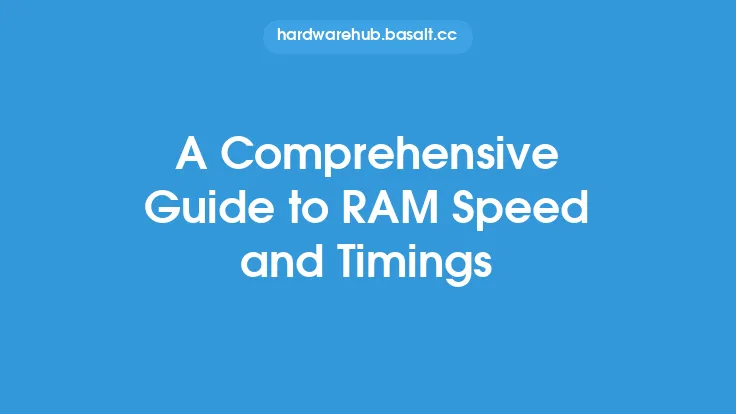When it comes to building or upgrading a computer, one of the most critical components to consider is the Random Access Memory (RAM). RAM plays a vital role in determining the overall performance of a system, and its compatibility with the motherboard is essential for ensuring optimal functionality. In this article, we will delve into the world of RAM compatibility and motherboard specifications, providing a comprehensive guide to help you make informed decisions when selecting RAM for your system.
Introduction to RAM Types
RAM comes in various types, each with its unique characteristics, advantages, and compatibility requirements. The most common types of RAM include DDR3, DDR4, and DDR5. DDR3 RAM is an older generation and is mostly used in legacy systems, while DDR4 and DDR5 are the latest generations, offering faster speeds and higher capacities. DDR4 RAM is widely used in modern systems, while DDR5 RAM is the latest addition to the market, offering even faster speeds and higher capacities. Each type of RAM has its specific specifications, such as speed, voltage, and timings, which must be compatible with the motherboard to ensure proper functioning.
Motherboard Specifications
The motherboard is the main circuit board of a computer, connecting all the hardware components together. When it comes to RAM compatibility, the motherboard plays a crucial role. The motherboard specifications, such as the chipset, socket type, and RAM slots, determine the type and amount of RAM that can be installed. The chipset is the brain of the motherboard, controlling the flow of data between the CPU, RAM, and other components. The socket type determines the type of CPU that can be installed, while the RAM slots determine the type and amount of RAM that can be installed. Common motherboard specifications include the number of RAM slots, the type of RAM supported (e.g., DDR4 or DDR5), and the maximum capacity of RAM that can be installed.
RAM Speed and Timings
RAM speed and timings are critical factors to consider when selecting RAM for your system. RAM speed is measured in MHz (megahertz) and determines how fast the RAM can transfer data. Faster RAM speeds result in better system performance, especially in applications that require high memory bandwidth, such as gaming and video editing. RAM timings, on the other hand, refer to the delay between the RAM receiving a command and executing it. Lower timings result in faster performance, while higher timings can lead to slower performance. Common RAM timings include CAS (Column Address Strobe) latency, RAS (Row Address Strobe) latency, and command time. When selecting RAM, it's essential to ensure that the speed and timings are compatible with the motherboard to avoid any performance issues.
Dual Channel and Quad Channel RAM
Dual channel and quad channel RAM configurations are designed to increase memory bandwidth and improve system performance. Dual channel RAM configurations use two RAM modules of the same capacity and speed, installed in parallel, to increase memory bandwidth. Quad channel RAM configurations use four RAM modules of the same capacity and speed, installed in parallel, to further increase memory bandwidth. These configurations require specific motherboard support and RAM module compatibility to function properly. When selecting RAM for a dual or quad channel configuration, it's essential to ensure that the RAM modules are identical and compatible with the motherboard to avoid any performance issues.
RAM Voltage and Power Consumption
RAM voltage and power consumption are critical factors to consider when selecting RAM for your system. RAM voltage refers to the voltage required by the RAM to function properly, while power consumption refers to the amount of power required by the RAM to operate. Higher voltage RAM requires more power to operate, which can lead to increased heat generation and power consumption. Lower voltage RAM, on the other hand, requires less power to operate, resulting in reduced heat generation and power consumption. When selecting RAM, it's essential to ensure that the voltage and power consumption are compatible with the motherboard and power supply to avoid any performance issues or system instability.
ECC RAM and Registered RAM
ECC (Error-Correcting Code) RAM and registered RAM are specialized types of RAM designed for specific applications. ECC RAM is designed to detect and correct data errors, making it ideal for applications that require high data integrity, such as servers and data centers. Registered RAM, on the other hand, is designed to improve signal integrity and reduce noise, making it ideal for applications that require high memory bandwidth, such as gaming and video editing. ECC RAM and registered RAM require specific motherboard support and are typically more expensive than standard RAM. When selecting RAM for a specific application, it's essential to ensure that the RAM type is compatible with the motherboard and meets the required specifications.
Conclusion
In conclusion, RAM compatibility and motherboard specifications are critical factors to consider when building or upgrading a computer. Understanding the different types of RAM, motherboard specifications, RAM speed and timings, dual channel and quad channel configurations, RAM voltage and power consumption, and specialized RAM types can help you make informed decisions when selecting RAM for your system. By ensuring that the RAM is compatible with the motherboard and meets the required specifications, you can optimize system performance, reduce the risk of system instability, and ensure that your computer runs smoothly and efficiently. Whether you're a beginner or an experienced user, this comprehensive guide provides the essential information you need to navigate the complex world of RAM compatibility and motherboard specifications.





